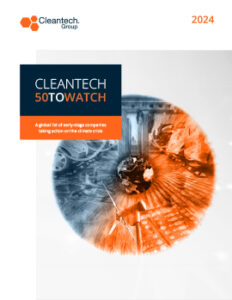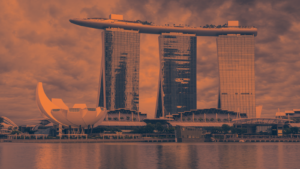Q3 2023 Quarterly Investment Insights
Much has been made of the challenging macroeconomic environment facing cleantech over this past year – high interest rates are slowing or even choking off projects downstream, while innovation at the earlier stages must find ways to grow with access to fewer venture dollars than in previous years. However, beneath the surface, we are observing shifts in the dynamics of cleantech innovation that offer cause for optimism.
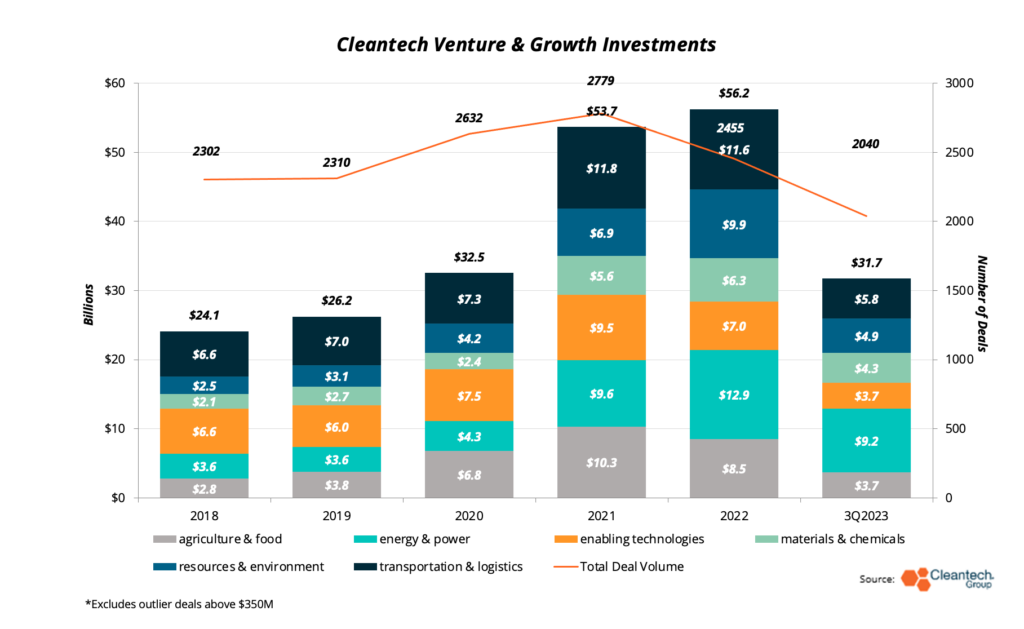
As discussed in the 2023 Trend Watch included in our annual Cleantech 50 to Watch report, cleantech innovators are angling toward the more challenging problems in climate change, while at the same time getting younger and coming from more diverse geographies. Seed investments are a higher percentage of overall venture investments now more than ever. While the chart above clearly indicates a drop in investments from the 2021 and 2022 funding craze, the concern over a hard landing has begun to evolve into preparation for a long tail for those ready to compete over the long run, in challenging segments.
In the third quarter of 2023, we saw a few of these trends develop even further. Clear now is that the spike in Asia-Pacific fundraising rounds initially observed in our APAC Cleantech 25 will now be one of the headlines of 2023. Growth investments in APAC-based innovators has comprised its highest percentage since we began tracking the region a decade ago. What’s more, in three quarters of 2023, the region has recorded as many dollars invested and nearly as many deals as in all of 2022.
\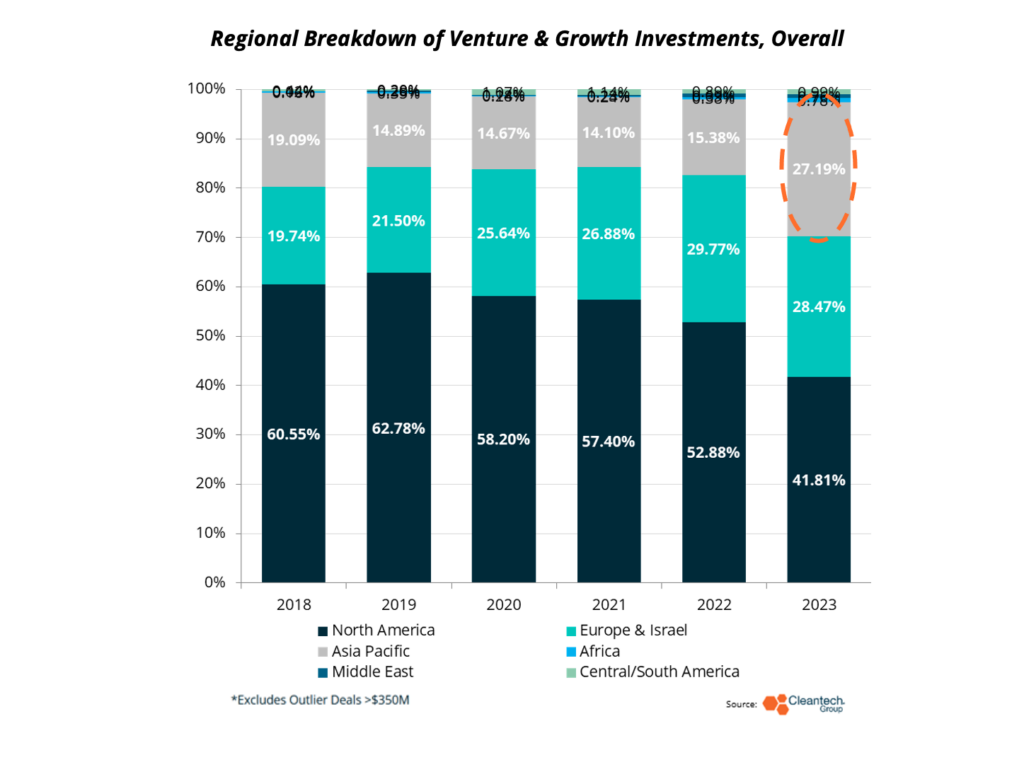
Embedded in this trend is the significant traction that APAC-based innovators in upstream components for Energy & Power have been able to build in recent years. We have noted throughout the past few years that, while long-recognized as the battery and renewables manufacturing powerhouse of the world, APAC-based innovation is pushing the envelope in materials innovation and quality products in these spaces.
As a result, it is no coincidence that that Energy & Power investments have exploded in the region while Materials & Chemicals investments in 2023 have just edged out their total in 2022. Notable deals in these sectors this past quarter included:
- Hithium (China), an innovator in lithium-ion batteries and core components, raised $622M from a consortium of mostly China-based investors. Hithium’s capabilities extend beyond battery production to optimization of electrode materials and battery recycling technologies.
- I-Pulse (Singapore), a nano-electronics company with technology to create high-power, highly precise electronic pulses for advanced manufacturing of metals and mining, raised a $79.4M round.
- Sinoscience Fullcryo (China), an innovator in cryogenic liquification of hydrogen (for storage and transport) raised a $110.5M growth equity round.
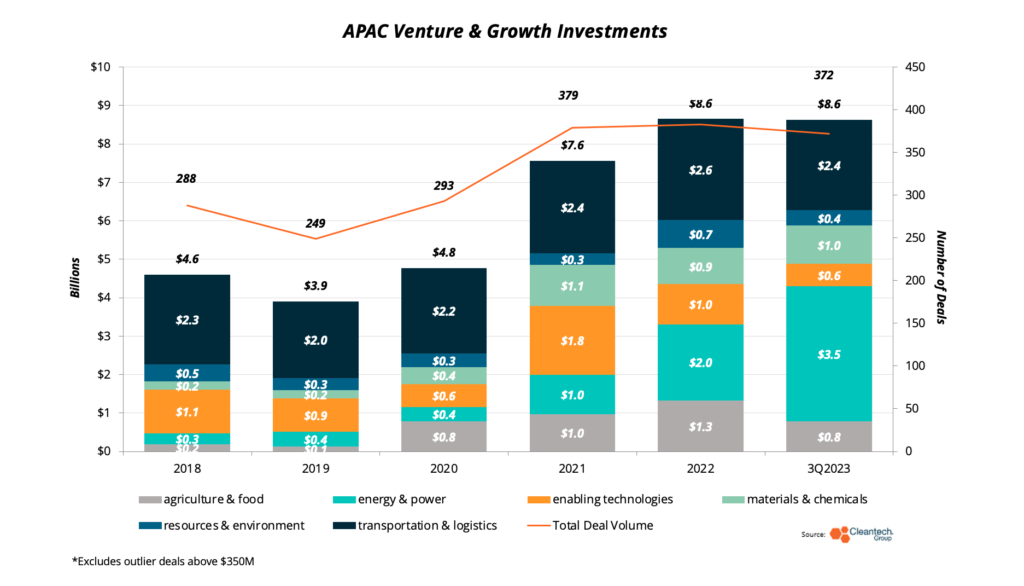
Elsewhere in the battery ecosystem, French lithium-ion module producer Verkor raised a $907M growth equity round for its gigafactory in Dunkirk. Innovators in graphene – a lightweight, high-strength material central to advances in battery conductivity – saw a breakout quarter:
- Lyten, an innovator with a novel reactor technology to produce 3D graphene from methane, raised $207M. Lyten’s technology is expected to be significant to advances in lithium-sulfur energy storage, a high-density, lower-cost energy storage approach that relies on fewer critical materials.
- General Graphene, an innovator in graphene production using chemical vapor deposition, closed a $4.8M round.
- BeDimensional will advance their proprietary 2D graphene crystal manufacturing technique with a $5.3M fundraising round.
This notable quarter in graphene production appears on its face to be an outlier, but it gels with a trend that we’ve observed over the past year. Novel manufacturing techniques around battery materials are continuing to gain corporate and investor attention, as the competitive advantages in lithium-ion batteries are more-and-more formed at nanoscale production improvements (see recent Perspective on cathode manufacturing innovation).
As battery materials manufacturing becomes more sophisticated, infrastructure for onshore supply chains continues to strengthen. While battery recyclers will need to work with manufacturing scrap until battery supply from end-of-life vehicles comes online, we can clearly see which recyclers have put a flag in the ground to manage the reverse supply chains when they materialize. In the U.S., Redwood Materials raised a $1B round while Ascend Elements raised a $542M round, further strengthening their position in the market.
Stepping away from the Energy & Materials nexus, the Agriculture & Food industry group was one of the few that experienced no drop-off in fundraising amounts from Q2 to Q3. More significantly, this past quarter was the first time in years that alternative proteins were not even in the top three Ag & Food sectors receiving funding.
The majority of funding this quarter went to precision agriculture, crop inputs, and technologies for animal and aquaculture management. The trend in crop inputs is a continuation of one we’ve observed for the past few years (see call-out in deep tech section of the Cleantech 50 to Watch Trend Watch) – global crop output must serve a growing global population in the face of weather pattern changes – inputs to make crops more productive and resilient are likely to be a trend for years to come.
Some key deals in crop inputs and decarbonization of animal proteins this quarter included:
- Atlas Agro (Switzerland) plans to expand production of green nitrate-based fertilizers to the Americas with its recent $325M round.
- Microbial crop nutrition and protection innovator Aphea.Bio (Belgium) raised a $78M Series C round, citing goals to fund pilots and expand facilities.
- Low-impact fish farming technology innovator eFishery (Indonesia) raised a $200M found from a series of blue-chip APAC investors, including Temasek and SoftBank.
- CH4 Global (U.S.) has engineered a seaweed-derived livestock feed supplement to reduce methane emissions from enteric fermentation. The company raised a $29M Series B this quarter.
A reason for optimism in Q3’s fundraising numbers is that while some industry groups saw a pullback by investors, participation from corporate investors is mostly consistent with recent years, and in absolute numbers will still outpace the pre-pandemic years. This is a critical indicator that the downstream demand owners are remaining interested in the technologies that are still undergoing development today.
Corporate engagement – be it through investments or partnerships – developed in clear themes throughout Q3 as well. Some key developments occurred in:
- Nuclear fusion. Sumitomo announced a partnership with Tokamak Energy (UK) for joint technology development. Helion (U.S.) and Nucor partnered to develop a 500MW fusion power plant, specifically for applications in steel production.
- Precision agriculture. Precision-spraying innovator Smart Apply (U.S.) was acquired by John Deere. Bayer and CRISPR innovator Pairwise (U.S) announced a partnership to develop applications for short-stature corn.
- Carbon capture, use, storage (CCUS) – Amazon continues to invest in and partner with CCUS innovators, entering into an agreement with 1pointfive (U.S.) and CarbonCapture (U.S.) to capture up to 350,000 tons of emissions. Carbon Engineering (Canada) was acquired by Occidental Petroleum for $1.1B, with plans to use the technology in 100 direct air capture plants.
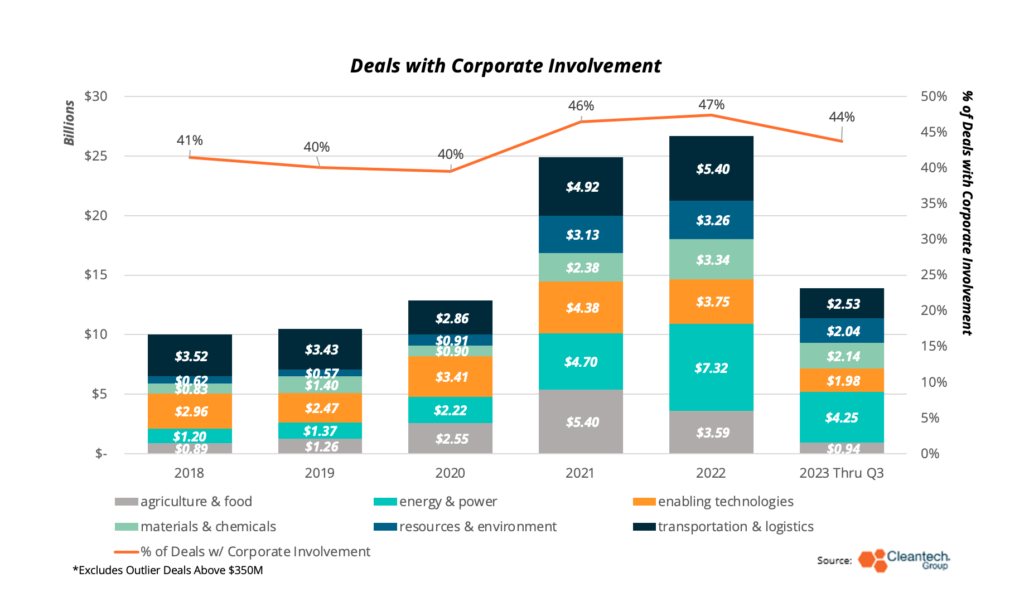
We look forward to bringing you our take on 2023 Q4 trends in early 2024. Keep an eye out for the 2024 Global Cleantech 100 list, also due out in early 2024, where we will look at these same trends through a year-in-review lens and deliver our perspective on the 100 most promising cleantech innovators in the ecosystem today.
